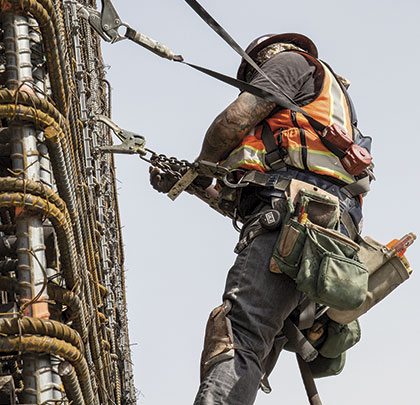During construction of San Francisco’s Golden Gate Bridge in the early 1900s, safety-conscious chief engineer, Joseph Strauss, was considered quite an innovator when he stretched a giant net beneath workers to save them from plunging into the waters below. At the time, the rule of thumb for large construction projects was suffering at least one fatality for each million spent on the job. Fortunately, efforts to reduce the number of fall-related fatalities on construction jobsites have improved dramatically over the years, but there is still more that can be done. According to data from recent years, fatal falls from height continue to represent more than a third of total construction deaths each year. Confronting a challenge like this requires a thoughtful and organized approach.
Jobsite safety specialists point to the ABCDs of basic fall protection as a great place to start:
A: is for the Anchorage Point (commonly referred to as a tie-off point) which is any structure (like an I-beam) that supports the fall-protection system. An Anchorage connector (like an anchor strap) joins the connecting device to the anchorage point.
B: is for the Body Harness worn by workers to connect them to the fall protection system.
C: is for the Connecting Device that attaches to the D-rings of the body harness and joins the worker to an anchorage connector like a self-retracting lifeline.
D: is for the Descent or Rescue plan for a fallen worker. This is a critical part of any fall protection program; winch systems are often used.
IT DOESN’T HAVE TO BE COMPLICATED
In a nationwide outreach campaign, OSHA has identified three simple steps that can help prevent falls and save lives. They are: Plan, Provide, and Train. OSHA is calling attention to this approach during its National Safety Stand-Down from May 2-6 this year. This voluntary event gives employers an outstanding opportunity to talk to their employees directly about the importance of fall prevention and safety in general.
PLAN ahead to get the job done safely.
When working from heights, such as ladders, scaffolds, and roofs, employers must plan projects to ensure that the job is done safely. It is important to begin by deciding how the job will be done, what tasks will be involved, and what safety equipment may be needed to complete each task.
When estimating the cost of a job, employers should include safety equipment, and plan to have all the necessary equipment and tools available at the construction site. For example, in a roofing job, think about all of the different fall hazards, such as holes or skylights and leading edges, then plan and select fall protection suitable to the work, such as personal fall arrest systems.
PROVIDE the appropriate equipment.
Workers who are 6 feet or more above lower levels are at risk for serious injury or death if they should fall. To protect these workers, employers must provide fall protection and the right equipment for the job, including the right kinds of ladders, scaffolds, and safety gear.
Different ladders and scaffolds are appropriate for different jobs. Always provide workers with the kind they need to get the job done safely. For roof work, there are many ways to prevent falls. If workers use personal fall arrest systems, provide a harness for each worker who needs to tie off to the anchor. Make sure the system fits the individual, and regularly inspect all fall protection equipment to ensure it’s still in good condition and safe to use.
TRAIN everyone to use the equipment safely.
Falls can be prevented when workers understand proper set up and safe use of equipment, so they need training on the specific equipment they will use to complete the job. Employers must train workers in hazard recognition and in the care and safe use of ladders, scaffolds, fall protection systems, and other equipment they’ll be using on the job every day.
OSHA has provided numerous materials and resources that employers can use during Toolbox Talks to train workers on safe practices to avoid falls in construction. Falls from ladders, scaffolds, and roofs can be prevented and lives can be saved using these three simple steps.
FALL PREVENTION IS A PASSION
One of the country’s leading suppliers of construction tools, supplies, and materials, HD Supply White Cap, has also been working hard to get the word out. They have Safety Specialists across the country whose sole focus is helping busy contractors plan the most effective way to implement safety measures that are geared to each individual jobsite. The company provides a deep and comprehensive selection of safety equipment from the best names in the industry. Another way HD Supply increases awareness of fall prevention is through on-the-jobsite training. Their fleet of Safety Awareness Trailers visits jobsites nationwide supporting contractors with specialized presentations and training on the appropriate and effective use of fall protection equipment.
PLAYING IT SAFE IS SMART
There is no shortage of reasons to make fall prevention a priority on the jobsite. It saves time, money, and most importantly—worker’s lives. Gone are the days when daredevil workers strolled harness-and-hardhat-free along girders during the construction of New York’s famed Empire State Building. Today’s pro contractors have an arsenal of available training, safety equipment, and systems to choose from to help them protect their crews. ■
For More Information: For more information about fall protection and HD Supply White Cap’s Safety Specialists, visit www.whitecap.com.
_________________________________________________________________________
Modern Contractor Solutions – March 2016
Did you enjoy this article?
Subscribe to the FREE Digital Edition of Modern Contractor Solutions magazine.

Rising to the Challenge of Fall Prevention


